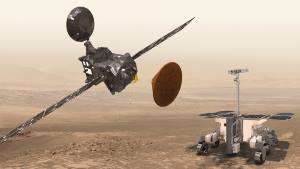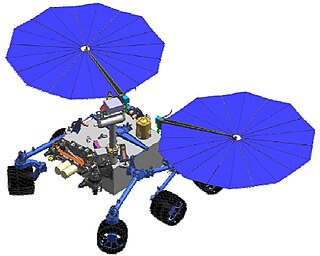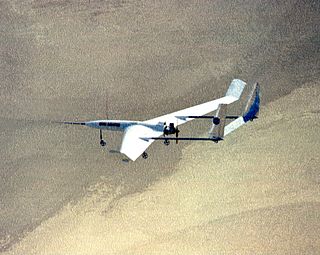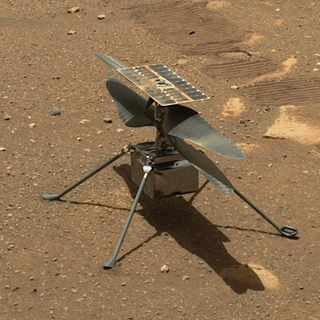
A lander is a spacecraft that descends towards, comes to rest on, the surface of an astronomical body. In contrast to an impact probe, which makes a hard landing that damages or destroys the probe upon reaching the surface, a lander makes a soft landing after which the probe remains functional.

A Mars rover is a motor vehicle designed to travel on the surface of Mars. Rovers have several advantages over stationary landers: they examine more territory, they can be directed to interesting features, they can place themselves in sunny positions to weather winter months, and they can advance the knowledge of how to perform very remote robotic vehicle control. They serve a different purpose than orbital spacecraft like Mars Reconnaissance Orbiter. A more recent development is the Mars helicopter.

The planet Mars has been explored remotely by spacecraft. Probes sent from Earth, beginning in the late 20th century, have yielded a large increase in knowledge about the Martian system, focused primarily on understanding its geology and habitability potential. Engineering interplanetary journeys is complicated and the exploration of Mars has experienced a high failure rate, especially the early attempts. Roughly sixty percent of all spacecraft destined for Mars failed before completing their missions and some failed before their observations could begin. Some missions have met with unexpected success, such as the twin Mars Exploration Rovers, Spirit and Opportunity which operated for years beyond their specification.

ExoMars is an astrobiology programme of the European Space Agency (ESA).

A sample-return mission is a spacecraft mission to collect and return samples from an extraterrestrial location to Earth for analysis. Sample-return missions may bring back merely atoms and molecules or a deposit of complex compounds such as loose material and rocks. These samples may be obtained in a number of ways, such as soil and rock excavation or a collector array used for capturing particles of solar wind or cometary debris. Nonetheless, concerns have been raised that the return of such samples to planet Earth may endanger Earth itself.

A Mars sample-return (MSR) mission is a proposed mission to collect rock and dust samples on Mars and return them to Earth. Such a mission would allow more extensive analysis than that allowed by onboard sensors.

The idea of sending humans to Mars has been the subject of aerospace engineering and scientific studies since the late 1940s as part of the broader exploration of Mars. Some have also considered exploring the Martian moons of Phobos and Deimos. Long-term proposals have included sending settlers and terraforming the planet. Proposals for human missions to Mars came from e.g. NASA, Russia, Boeing, and SpaceX. As of 2022, only robotic landers and rovers have been on Mars. The farthest humans have been beyond Earth is the Moon.

A Mars landing is a landing of a spacecraft on the surface of Mars. Of multiple attempted Mars landings by robotic, uncrewed spacecraft, ten have had successful soft landings. There have also been studies for a possible human mission to Mars, including a landing, but none have been attempted. Soviet Union’s Mars 3, which landed in 1971, was the first successful Mars landing. As of May 2021, the Soviet Union, United States, and China have conducted Mars landings successfully.

Jezero is a crater on Mars in the Syrtis Major quadrangle, about 45.0 km (28.0 mi) in diameter. Thought to have once been flooded with water, the crater contains a fan-delta deposit rich in clays. The lake in the crater was present when valley networks were forming on Mars. Besides having a delta, the crater shows point bars and inverted channels. From a study of the delta and channels, it was concluded that the lake inside the crater probably formed during a period in which there was continual surface runoff.

The Mars Astrobiology Explorer-Cacher (MAX-C), also known as Mars 2018 mission was a NASA concept for a Mars rover mission, proposed to be launched in 2018 together with the European ExoMars rover. The MAX-C rover concept was cancelled in April 2011 due to budget cuts.

A Mars aircraft is a vehicle capable of sustaining powered flight in the atmosphere of Mars. So far, the Mars helicopter Ingenuity is the only object to ever fly on Mars, completing 34 successful flights covering 7.48 km (4.65 mi) in 59 minutes 0 seconds of flight time.

Mars 2020 is a Mars rover mission forming part of NASA's Mars Exploration Program that includes the rover Perseverance, the small robotic, coaxial helicopter Ingenuity, and associated delivery vehicles. Mars 2020 was launched from Earth on an Atlas V launch vehicle at 11:50:01 UTC on 30 July 2020, and confirmation of touch down in the Martian crater Jezero was received at 20:55 UTC on 18 February 2021. On 5 March 2021, NASA named the landing site of the rover Octavia E. Butler Landing. As of 28 November 2022, Perseverance and Ingenuity have been on Mars for 631 sols.

The Next Mars Orbiter is a proposed NASA Mars communications satellite with high-resolution imaging payload and two solar-electric ion thrusters.
The following outline is provided as an overview of and topical guide to Mars:

Ingenuity, nicknamed Ginny, is a small robotic helicopter operating on Mars as part of NASA's Mars 2020 mission along with the Perseverance rover, which landed with Ingenuity attached to its underside on February 18, 2021. The helicopter was deployed to the surface on April 3, 2021, and on April 19 successfully made the first powered controlled extraterrestrial flight by an aircraft, taking off vertically, hovering and landing for a flight duration of 39.1 seconds. As of its 34th flight, on 10 November 2022, the helicopter had remained flightworthy for 523 days after its first flight. The 25th flight, which occurred on April 8, 2022, set new records for highest speed and distance traveled.

Perseverance, nicknamed Percy, is a car-sized Mars rover designed to explore the Jezero crater on Mars as part of NASA's Mars 2020 mission. It was manufactured by the Jet Propulsion Laboratory and launched on July 30, 2020, at 11:50 UTC. Confirmation that the rover successfully landed on Mars was received on February 18, 2021, at 20:55 UTC. As of 28 November 2022, Perseverance has been active on Mars for 631 sols since its landing. Following the rover's arrival, NASA named the landing site Octavia E. Butler Landing.

The Mars 2020 mission and its rover, Perseverance, and helicopter Ingenuity, were launched from Earth on 30 July 2020. On 15 February 2022, The New York Times reported an overview of Mars 2020 mission events since landing in Jezero crater on Mars in February 2021. As of November 25, 2022, Perseverance has been on the planet Mars for 628 sols.
















